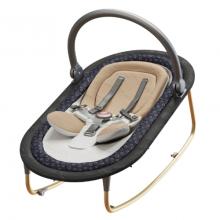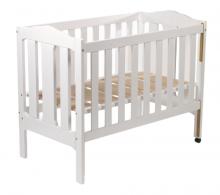There are many products that are marketed for infants (babies under 12 months of age). They are for uses such as play, transport, soothing or sleep.
Sleeping infants are at risk of sudden death due to suffocation, entrapment or strangulation if they are left sleeping in unsuitable products.
The risk can increase if products place an infant in a position that is:
- inclined or propped
- curved
- restrained.
Understanding risks with infant products
Infant products can be categorised as:
- infant inclined products
- infant non-inclined sleep products
- infant sleep related products.
These products can have design features that can cause suffocation, positional asphyxiation, entanglement or strangulation.
The design features which pose a risk include:
- incline of the products
- curve of the backrest
- soft and padded surfaces
- pillows that lift the infant’s head
- products that add weight or restrict movement.
Risks of products with an incline
Sleeping on an incline increases the risk of sudden death for infants.
Infant inclined products can cause suffocation or positional asphyxiation. This occurs when an infant’s head falls forward while in an inclined product and their chin can drop to their chest. This can cause their airways to become blocked and reduce oxygen flow.
An infant’s airflow can also become restricted if they roll within an inclined product and their face has partial or complete contact with the side of the product. This can reduce oxygen and lead to carbon dioxide re-breathing.
Risks of products with a curved backrest
Products with a curved backrest, whether firm or soft, can compromise breathing by:
- placing the infant on an incline
- curling the infant and:
- putting them into a chin on chest position
- restricting chest and tummy movement.
Using infant inclined or sleep products that have a curved back is not recommended.
Risks of soft and padded surfaces
Soft and padded surfaces can prevent infants from being able to turn or lift their face to breathe freely if they roll over. This is an even greater risk if they roll over because they have been placed on an incline.
Infants should be placed to sleep on their backs - for every sleep. However, at some point, they will roll over onto their tummy. When that happens, they need to use their muscles to lift and turn their head so that they can breathe safely. This is much easier if the mattress is firm, flat and level.
Moveable soft sleep related products can cover an infant’s face and cause suffocation. For this reason, placing soft toys, sleep comforters, pillows, bumpers, or blankets in an infant’s sleeping area is not recommended.
Heightened risk factors
The risks outlined above increase when:
- these products are used in an infant’s sleep environment – even when placed within a sleeping area such as a cot
- infants are propped on these products
- infants fall asleep on products that are intended to soothe or settle
- infants are not supervised when using these products
- safe sleeping practices are not followed.
Examples of infant inclined products
Infant inclined products position infants at an inclined angle. These products can be designed for transport, playing, resting, or soothing or sleeping an infant. Some products that fall within this category include:
Play:
- rockers
- bouncers
- swings
Soothing and sleeping:
- hammocks
- recliners
- infant bean bags
Transport:
- car restraints
- prams and strollers
- slings (infant wearing).
Some transport products place infants on an incline. This may be necessary such as for crash protection. There may be a function to lie the infant flat when asleep, as with prams or strollers. More information about these products is available in safe sleep for infants, on Your First Steps, and in the mandatory standard for child restraints.
Infant wearing is another situation where the infant can fall asleep on an incline. Risks can be reduced by selecting a product which is suited to the development of your infant and where your infant is held upright with a flat back.
Product examples
| Inclined sleeper/bouncer/rocker | Baby swing | Baby hammock | |
|---|---|---|---|

|

|

|

|
Examples of infant non-inclined sleep products
Infant non-inclined sleep products are those marketed for infants to use for sleeping. They include products such as:
- cots
- co-sleepers
- folding cots
- bassinets
- cradles.
It’s important to use infant sleep products correctly. Avoid creating any incline for sleeping when using these products even if some designs allow for it. These products and the product’s mattress base should be installed on a flat surface so that your infant can lie flat, not propped or elevated in any way. For cradles with rocking mechanisms, the cradle should be locked when the infant is asleep to avoid them becoming trapped if they roll to the side. You can find more information about these products on the Your First Steps website, including tips and checklists for safe use. Before you purchase these products, you should also check:
- mandatory standard for cots and mandatory standard for folding cots for safety requirements
- lists of recalled products.
Product example
| Household cot | Folding cot | Bassinet |
|---|---|---|

|

|

|
Examples of infant sleep related products
Infant sleep related products may be marketed to assist in getting your infant to sleep. Some examples of these products include:
- anti-roll pillows
- anti flat head pillows
- sleep positioners
- nests or loungers
- weighted blankets
- soft toys.
Soft and padded surfaces can prevent infants from being able to self-correct if they roll over. Infants may not have enough strength to lift their heads to breathe.
Soft and padded surfaces conform to the shape of an infant’s head instead of remaining rigid. This increases the chance of suffocation and carbon dioxide rebreathing.
Soft sleep related products can cover an infant’s face and cause suffocation. For this reason, placing soft toys, sleep comforters, pillows, or blankets in an infant’s sleeping area is not recommended.
Product example
Baby lounger

How important it is to have a safe sleep product
Based upon reports from Child Death Review and Prevention Groups between 2001 and 2021, 151 infants in Australia died in inclined products such as rockers, bouncers, and on items that were propped.
At present, the ACCC estimates that the total number of infant fatalities in Australia associated with infant sleep products and inclined sleep products annually are:
- around 3 infant fatalities per year for inclined sleep products
- around 8 infant fatalities per year for infant non-inclined sleep products.
Safe sleep for infants
Often parents and carers are unaware of the risks associated with infant products. When your infant is sleeping, it's important to follow the instructions to minimise these risks.
Red Nose safe sleep recommendations advise placing infants to sleep:
- on a firm, flat, level surface
- removing any loose items - such as blankets, soft toys, sleep aids and comforters.
Red Nose guidance also indicates that long periods in car restraints or capsules can also be risky for infants. We recommend consulting Red Nose’s recommendations for car seat use at: Are there recommendations for car seat or baby seat use?
On longer journeys, it is advisable to stop every hour and take the infant out of the car restraint. Check colour and breathing and level of alertness before resuming the journey.
Visit the ACCC’s Your First Steps website and Red Nose safe sleep recommendations for additional information and advice on safe sleeping practices.
Product safety standards
Currently, outside of the mandatory standard for cots and mandatory standard for folding cots, there are no existing mandatory or voluntary standards in Australia that apply to infant inclined products.
The ACCC has been working with industry and consumers since 2021 to address this issue. We published an Issues paper and Consultation paper outlining this work.
The outcome of this consultation was to develop a safety standard and an education campaign to help consumers and industry be aware of the product safety risks.
Infant inclined products sold in Australia may comply with international standards or regulations. International standards and regulations for these products have varying requirements. Some may require a safety warning that the product is not safe for unsupervised sleep by infants.
Suppliers selling infant inclined products
There are steps suppliers can take to minimise the risk of these products. They include:
- providing warnings to consumers on potential risks associated with these products
- providing instructions on how to use the product safely
- reviewing infant inclined product lines to ensure they are safe for use
- assessing whether a product could be misused and result in an increased risk of death or serious injury
- make sure marketing and promotional material of infant products is consistent with safe sleep advice.
Read the Infant Safe Sleeping Working Group best practice guide for the design of safe infant sleeping environments for further information.
Resources
Infant Inclined Products and Infant Sleep Products – Consultation Regulation Impact Statement
The ACCC has published a consultation paper seeking feedback on regulatory options to address the risks associated with Infant Sleep Products, including Infant Inclined Products.
Date published:
11 August 2022
ACCC launches Your First Steps to help parents keep their infant safe
Parents and carers can get the latest, most reliable information on best practices to keep their baby safe and unsafe products, as part of a new ACCC initiative.
Date published:
1 Aug 2022
Related recalls
- Twinkle Kids and Infant — Newborn Self-feeding Pillow – 2 May 2023
- Boho Infant Australia — Kalu Cot – 29 Mar 2023
- Bubpods Trading Pty Ltd — Bubpods Sleep Sack – 9 Jan 2023
- The Amazing Infant Company (TABC) — 4moms mamaRoo Multi-motion Infant Swing and rockaRoo Infant Rocker – 16 Nov 2022
- Internet Traders Pty Ltd — Star Kidz Vivo Super Light Travel Folding Cot – 7 Dec 2022
- Mattel Pty Ltd — Fisher Price Dots and Spots Puppy Deluxe Swing Plug-in Adaptor – 15 Nov 2021
- BPM Australia Pty Ltd — Boppy Hug & Nest Newborn Lounger – 24 Sep 2021
- Pharmrec Trading Pty Ltd — Mamakiddies Happy Dino Portable Travel Cot – 25 Aug 2021
- eBay seller gadget_arcade — Infant Multi-functional Adjustable Cot Convertible Table Mattress Mosquito Net – 23 May 2021
- Target Australia Pty Ltd — Target Safety Bed Rail – 24 Feb 2020
- Bubs Warehouse — Tummy Time Water Inflatable Development Mat – 11 Feb 2020
- Union Australia Pty Ltd — Cool Infant Portable Cot – 8 Aug 2019
- Price Down Gallery Pty Ltd — Bubs Gallery Travel Cot – 24 Jul 2019
- Kids II Australia Pty Limited — Various Rocking Sleepers – 6 Jun 2019
- Mattel Pty Ltd — Fisher-Price Rock 'N Play Sleeper – 2 May 2019
- Danish by Design Pty Ltd—Bednest Bassinet – 12 Feb 2016


